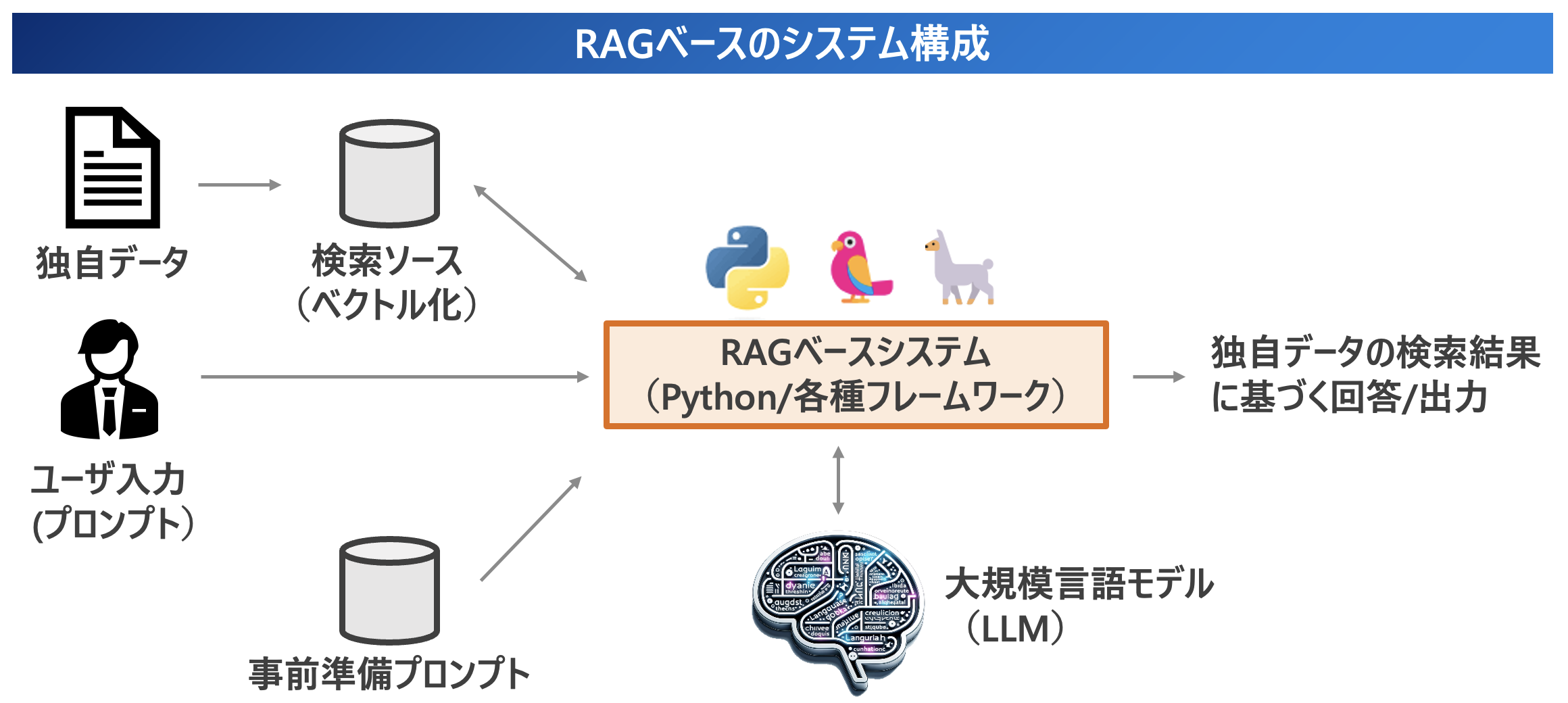Evolution of large-scale language models and their application to business
With the wave of digital transformation (DX) demanded in all areas of business, the introduction and application of new AI-based technologies has become indispensable to enhance corporate competitiveness. In recent years, AI-based natural language processing technology has played a part in this trend and has made dramatic progress. In particular, the emergence of Large Language Models (LLMs) has enabled a wide range of applications in the business domain and is showing signs of revolutionary change in corporate DX strategies.
THIS EVOLUTION OF LLM IS EXPECTED TO BE USED IN VARIOUS PHASES OF BUSINESS, FROM CUSTOMER SERVICE TO AUTOMATION OF INTERNAL OPERATIONS AND INFORMATION ANALYSIS. EXTRACTING KNOWLEDGE FROM LARGE AMOUNTS OF TEXT DATA AND BUILDING SOPHISTICATED QUESTION-AND-ANSWER SYSTEMS, WHICH HAVE BEEN DIFFICULT WITH CONVENTIONAL METHODS, ARE NOW BECOMING A REALITY WITH THE HELP OF LLM. SUCH TECHNOLOGICAL ADVANCEMENTS HAVE THE POTENTIAL TO ACCELERATE COMPANIES' SHIFT TO DX AND CREATE OPPORTUNITIES FOR NEW BUSINESS MODELS AND VALUE OFFERINGS.
EXAMPLES OF BUSINESS APPLICATIONS OF LARGE-SCALE LANGUAGE MODELS (LLMS) INCLUDE
- Customer Support
Traditionally, customer inquiries were handled manually by staff, but with the introduction of LLM, responses to common questions can be automated and handled even during busy times and after hours, which is expected to reduce labor costs and make more effective use of resources. - Content Creation
While previously costly and time-consuming to hire or outsource professional writers, LLM allows for rapid generation of text based on keywords, streamlining content creation to respond quickly to market trends. - Education Field
Traditionally, the teaching assistants (TAs) of faculty members were required to prepare and implement responses, but the introduction of LLMs will streamline the provision of automated feedback and provide support to more students. - Research Assistant
While manual information gathering and summary creation used to be time-consuming and costly, the use of LLM streamlines the rapid retrieval of relevant information and the creation of summaries of papers. - Entertainment
While the creation of story and dialogue content used to require high costs and time-consuming requests to specialized writers, the introduction of LLM enables efficient content production and reduces production costs.
Limitations of large-scale language models
By leveraging prior knowledge based on large amounts of learned data, LLM is expected to perform well and streamline tasks in these use cases. On the other hand, however, it may not fully meet specific business needs that require knowledge of unlearned proprietary data information, such as company-specific data.
For example, when we asked ChatGPT about our president, the answer was the name of a non-existent president (using GPT4; ChatGPT September 25 Version).
This phenomenon is known as "halucination" in LLM. Hallucination is a phenomenon in which LLM generates information and facts that do not actually exist, and is an issue that must be addressed as an inevitable occurrence in the use of LLM in business settings.
The characteristics of halucination can be summarized as follows
- Impact of Training Data
LLMs can only attempt to answer based on the data provided during training. It may generate answers for unlearned content that it does not know or does not know, but there is a risk that it will generate inaccurate information based on incorrect or similar information to answer the question. - Overreliance on general knowledge
Although LLMs are knowledgeable about a wide variety of topics, they may respond without specifying specific evidence or sources of information. This is due to a strong tendency to base answers on general knowledge. - Reliability of Information
LLM generates the most relevant responses to user questions, but not all of them may be accurate.
IN UTILIZING LLM IN BUSINESS SETTINGS, IT IS NECESSARY TO FULLY CONSIDER THE FUNCTIONAL LIMITS THAT LLM CAN HANDLE AND PROPERLY EVALUATE THE EFFECTIVENESS OF MODEL RESPONSES AND THE HANDLING OF INFORMATION UPDATES.
APPROACHES TO UTILIZING LLM WITH PROPRIETARY DATA
Approaches to address these issues by enabling LLMs to generate responses from information that has not been previously learned include supervised Fine-Tuning and Reinforcement Learning from Human Feedback (RLHF), which are methods for learning models, and Retrieval-Augmented Generation (RAG), which generates responses by referring to data provided outside the LLM, Retrieval-Augmented Generation (RAG), which generates responses by referring to data stored outside the LLM.
- Supervised Fine-Tuning (SFT)
This method uses a task-specific data set to tune the model. The greatest advantage of this approach is that models can be optimized based on data specific to that task. It is also relatively easy to implement and apply, and it is possible to obtain high-quality models in a short time. On the other hand, it requires GPU resources for model training, and there is a need for good quality task-specific data sets and the possibility of over-fitting certain patterns that are only present in the training data. - Reinforcement Learning from Human Feedback (RLHF):
This is an approach to learning models based on human feedback. Its great appeal is its flexibility to respond to subtle nuances and situations. In addition, it is valued for its ease of correcting specific errors made by the model. However, challenges exist that require human resources to obtain large amounts of high-quality feedback, as well as costly in time and money. - Retrieval-Augmented Generation (RAG)
This method leverages information from existing knowledge bases and databases to generate answers. This is expected to address a wide variety of questions and unknown topics. By integrating information retrieval and document generation, rich contextual answers are possible. On the other hand, the need to optimize both information retrieval and generation components increases the complexity of design and implementation, but several external tools are available to assist with this.
USE OF PROPRIETARY DATA IN LLM WITH RAGS
Below we describe Retrieval-Augmented Generation (RAG), which allows LLMs to leverage their own data without having to train models.
RAG is a method for improving the performance of natural language processing (NLP) models announced by then Facebook in 2020. By deploying RAG in LLM-based question answering systems, models can access up-to-date and reliable information from external sources, and users can access model sources to verify their accuracy. The model can access external, up-to-date, and reliable information. This can ensure that the information in the answers generated by the model is reliable.
The RAG consists of three main elements: Retrieval (Retriever), Combination and Adjustment (Augmentation), and Text Generation (Generator).
- Retriever: serves to efficiently extract the most relevant data from large amounts of information.
- Argumentation: Harmonize the retrieved information with the query from the user to form the appropriate input.
- Generator: Generates contextual text based on input.
With RAG, the search phase efficiently locates pieces of information relevant to the user's question or prompt, and generates answers using open data that the model has pre-trained, as well as closed data such as proprietary data, as sources of information, depending on the content of the search.
To actually implement the functionality of RAG, a dedicated library framework, separate from LLM, is used. An example of such a library is the following
- LangChain(in Japanese history)https://www.langchain.com/)

IT IS A FRAMEWORK FOR APPLICATION DEVELOPMENT THAT UTILIZES LANGUAGE MODELS. IT HAS CONTEXT-AWARENESS AND INFERENCE CAPABILITIES AND PROVIDES MODULAR COMPONENTS. IT IS EASY TO USE WITH A VARIETY OF CHAINS TO CONNECT LANGUAGE MODELS (LLMS) TO SENTENCE SOURCES, AND COMPONENTS ARE AVAILABLE TO CUSTOMIZE EXISTING CHAINS FOR MORE COMPLEX APPLICATIONS. - LlamaIndex(in Japanese history)https://www.llamaindex.ai/)

A data framework for building applications by incorporating specialized or private data into LLMs, LlamaIndex allows you to incorporate distributed, stored specific domain or private data into LLMs that have been pre-trained with large amounts of data. - haystack(in Japanese history)https://haystack.deepset.ai/)

A framework for building powerful, production-ready pipelines using LLMs for a variety of search use cases, including RAGs, question answering, and semantic search, using Haystack's advanced LLM and NLP models that allow users to query in natural language It can provide a custom search experience.
EACH LIBRARY OFFERS DIFFERENT FUNCTIONS. WHEN SELECTING A LIBRARY, PLEASE CHECK THE WEBSITE OF EACH LIBRARY TO SEE IF THE NECESSARY FUNCTIONS ARE AVAILABLE. ALSO, CONSIDER THE FOLLOWING POINTS
- Ease of use: A framework that is easily accessible and simple to implement is desirable.
- Flexibility: A framework that can be customized to meet unique requirements is effective.
- Performance: The ability to process large amounts of data is ensured.
- Scalability: The framework must be able to accommodate future expansion and changes.
- Support: Selecting a framework with a support structure and active community will facilitate troubleshooting and information exchange.

Summary and Future Prospects
RAG-based LLM systems can generate quick and accurate responses based on concrete facts, even for proprietary data such as internal data, and can be used to improve the efficiency of various business processes, such as customer support and FAQ auto-response. RAG-based LLM systems can generate quick and accurate responses based on concrete facts, even for proprietary data such as internal data, and can be used to improve the efficiency of various business processes, such as customer support and automated FAQ response.
ARAYAPLEASE FEEL FREE TO CONTACT US AT ARAYAIF YOU ARE CONSIDERING DEVELOPING A SYSTEM USING LLM WITH YOUR OWN DATA IN PLEASE CHECK THIS PAGE FOR DETAILS.

 Contact Us
Contact Us


